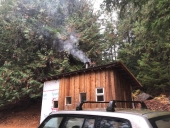
 3
3




Fox James wrote:The problem with coating ceramic fibre inside a heat riser is finding a suitable product to do the job!
However there is a product called Zircon that has recently come to my notice and is for sale from my refractory supplier.
I have not tried it although I will be ordering some ….
 4
4




Fox James wrote:The problem with coating ceramic fibre inside a heat riser is finding a suitable product to do the job!
If the stove has been built carefully to proven specification then there are very few materials that will stand the heat, especially near the bottom of the riser!
Water glass is something that is cheap and might work for some folk but from my own experiments it cracks very badly then leaves a lot of fibers exposed.
However there is a product called Zircon that has recently come to my notice and is for sale from my refractory supplier.
I have not tried it although I will be ordering some ….
 7
7




 2
2




Fox James wrote:I must of missed that post!
It has worked and appears to be still forming a crust on the surface though be it, pretty delicate.
The zircon works ok on ceramic board and I think might be ok on ceramic mat but it has badly cracked and flaked on vermiculite board.
Vitcas are experts and suggested their riigidiser would be the most suitable product they stock however that was several years ago and they have new products now.
Personally I am trying my best to stay way from ceramic fibre products and I am using cast thin wall risers with an outer tube filled with loose vermiculite. (Also can seen in my recent videos)
 2
2




 1
1




Fox James wrote:If you are concerned then perhaps use split brick and wrap that with ceramic fibre?
How do you intend to close the top of the bell or clean out the floor ash?
Personally I would want to have access to the core and riser.
Delicate in this context means the coating has been baked hard to the extent of being fragile, it is possible to crack it by pushing it with a finger.
You dont have to coat the fibre with anything and it should last for years but, it will by then have become a hazardous material and potentially deadly if breathed in!
So ‘delicate’ also means to me, that I have to be very careful not to break the coating that is containing the danger, but delicate does not mean the riser would not still Function.
 1
1




Chris McClellan wrote:Mud: The metal exoskeleton of the 5 minute riser can be hardware cloth or steel remesh (generally used to reinforce concrete) or my favorite is to use a piece of the next larger stovepipe. (Caution, hardware cloth is galvanized so it could offgas zinc at you). Life span has been about 3 years with the hardware cloth before needing a rebuild, longer with the stovepipe surround.

 6
6




For all your Montana Masonry Heater parts (also known as) Rocket Mass heater parts.
Visit me at
dragontechrmh.com Once you go brick you will never go back!
 6
6




thomas rubino wrote:Hi Mike;
A five minute riser using a section of stove pipe as a sleeve will last for many years.
I have two bathboxes, both in uninsulated buildings.
They burn all day every day in northern Montana, I call this severe duty batchbox burning.
Both risers are as solid as the day I installed them (several years back at the least)
I could see hardware cloth melting off over time and causing issues... so why use it?
Metal stove pipe is built to be installed on a typical box stove and have 700F+ temps for years.
They do not wear out as a direct chimney and they will not wear out as a riser sleeve.
In your insulated home with only a 3-month winter, you will be burning once or twice a day... a properly built 5 minute riser will last longer than you in that work environment.




Thomas Cleman wrote:What if one were to tile the susceptible area at the bottom of the riser with these? Graphite tiles.
You will get a very hot burn, once. Graphit burns like coal in the presence of oxygen.


|
Always! Wait. Never. Shut up. Look at this tiny ad.
The new permaculture playing cards kickstarter is now live!
https://www.kickstarter.com/projects/paulwheaton/garden-cards
|





